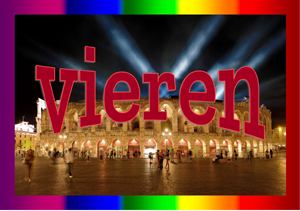Louise Müller
Wijsheidsweb, 5 december 2020
The Netherlands has a long history of celebrating Saint Nicholas Day. On the eve of the 5th of December, the Dutch commemorate the date of death of the popular bishop from Myra, who protected citizens and sailors and gave his money to the poor.
Bishop Nicholas, who came from a well-to-do Christian merchant family of Greek descent, lived in Asia Minor during the fourth century CE.
Today, during the European winter months, a version of Saint Nicholas (Sinterklaas) features prominently in Dutch public spaces, especially in shopping malls and bakeries.
Most often the saint is accompanied by one or more companions.

This article explores the possible Late Antique origins of these companion(s), who have recently become embroiled in heated Saint Nicholas debates in the Netherlands on Dutch racism and the slave trade.
I will posit that the Saint’s current companion(s) have semi-historical origins which may be traced back to North African grain merchants, traders and sailors who in Late Antiquity regularly sailed from Alexandria to Myra.
The proposal challenges contending theories that the Saint Nicholas legends did not have companions of African descent before the nineteenth century.
The investigation is significant for questions relating to the current transformations in the appearance of Saint Nicholas’ companion(s) and whether they should remain or rather be eliminated from the Dutch Saint Nicholas tradition.
Download: Louise-Müller-Saint-Nicholas’-beleaguered-black-companion(s), vol 65 (2020).
Nederland heeft een lange geschiedenis van het vieren van het Sinterklaasfeest.
Aan de vooravond van 5 december herdenken Nederlanders de datum van overlijden van Sint Nicolaas; de populaire bisschop uit Myra, die burgers en zeelieden beschermde en zijn geld aan de armen gaf.

Bisschop Nicolaas, afkomstig uit een welgestelde christelijke koopmansfamilie van Griekse afkomst, woonde gedurende de vierde eeuw in Klein-Azië.
Tijdens de Europese wintermaanden is Sinterklaas prominent aanwezig in de Nederlandse openbare ruimte, vooral in winkelcentra en bakkerijen. Meestal wordt de heilige vergezeld door één of meer metgezellen.
Dit artikel gaat in op de mogelijke laatantieke oorsprong van deze metgezellen, die onlangs onderdeel zijn geworden van verhitte Sinterklaasdebatten in Nederland over het Nederlandse racisme en de slavenhandel.
De auteur stelt dat de huidige metgezel(len) van de goed heiligman een semi-historische oorsprong hebben die terug te voeren is tot Noord-Afrikaanse graanhandelaren, kooplieden en zeelieden die in de late oudheid regelmatig van Alexandrië naar Myra zeilden.
In tegenstelling tot de opvatting van andere St. Nicolaas-wetenschappers gaat de onderzoeker er dus vanuit dat St. Nicolaas al Afrikaanse metgezellen had vóór de negentiende eeuw.
Dit nieuwe Sinterkaas onderzoek is van belang met betrekking tot vragen over de huidige transformaties in het uiterlijk van de metgezellen van Sinterklaas en of de helpers van deze heilige deel moeten blijven uitmaken van de Nederlandse Sinterklaas-traditie.
Download: Louise-Müller-Saint-Nicholas’-beleaguered-black-companion(s), vol 65 (2020).
Noot
[1] Saint Nicholas as the patron of the black African sea merchants, who he saves from drowning.
Source: Centro Studio Nicolaiani. The figure is of Medieval origin, exact year unknown. Public Domain.







